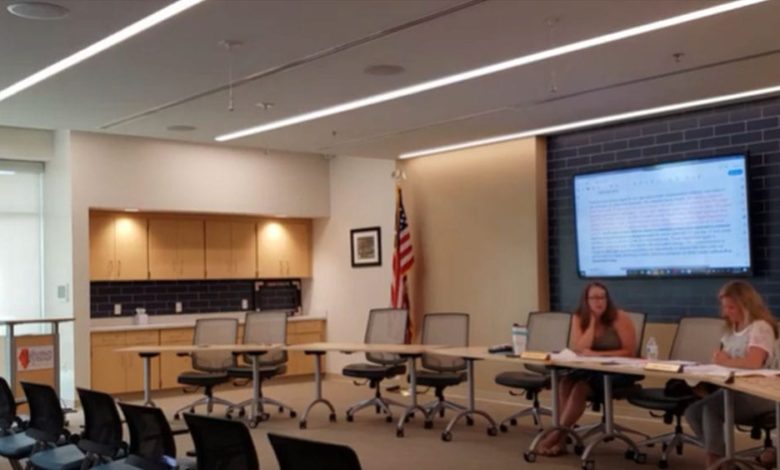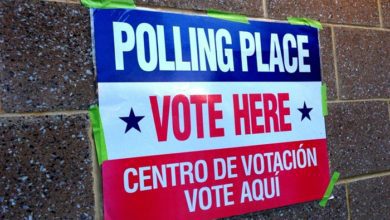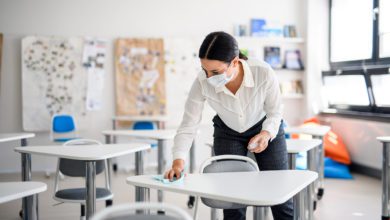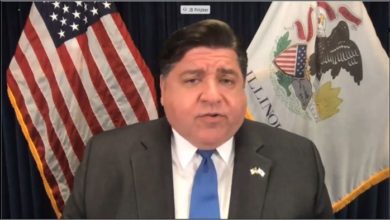Acceptable Use Policy revision leads to discussion about student data

BY DANI TIETZ
dani@mahometnews.com
Since the Mahomet-Seymour School District implemented a one-to-one initiative for grades 6-12, student device rights and policies have been a topic of conversation.
Meghan Hennesy, who was elected to the school board in April of 2019, is asking her fellow board members and district administration to consider a revision to the Acceptable Use/Responsible Use Policy that parents are prompted to acknowledge when they register their children for school.
Concerned parents contacted the district and board of education when they tried to register their children in 2018, but were prompted to accept the terms of the policy, to which they did not agree.
Board president Max McComb read a statement at the August 2018 board meeting, citing that children would be allowed to attend school, even if the policy was not signed by their parent.
The topic of the Acceptable Use Policy was once again broached by Hennesy in May 2019 when, as a board member, she was asked to vote on the Mahomet-Seymour Parent-Student Handbook, where the policy is located.
In the time between May and September, Hennesy took it upon herself to draft revisions to the policy, bringing it to the policy committee, which is comprised of herself and Lori Larson, on Sept. 30, 2019.
Hennesy’s revisions (attached below) seek to balance the responsibility of the device between the district and the parent and/or student.
“Technology is a tool and, as such, responsibilities fall upon both the student and the parent and the district in order to ensure that the tools are effective and safe and appropriate,” she said.
“The reason I brought this back is I didn’t feel like there was enough information about what the district was responsible for and it felt very one-sided to me and so this is my attempt to balance that out a little bit.”
Changes included definitions on what the district is monitoring when a student is using a district-owned device.
“I wanted to add that context as to the types of things that we would monitor kids for,” she said. “I felt like it was a little bit loose in the language to just say we’re gonna monitor everything at all times. I wanted to put some clarification as to why we would deem them inappropriate.”
She also feels it is appropriate for the district to provide what mechanisms are used to identify inappropriate or harmful behavior, how it will be tracked, how it will be reported, where the documentation will be located and how parents are notified of the activity.
She also feels that educating students on how to appropriately search for material online and how to communicate online is appropriate.
“I just wanted to put that in there because I think sometimes we forget that students, although they have access to all sorts of content online, can go down wormholes,” she said, “where you start on something pretty innocent and you’re getting to something that’s no longer appropriate pretty quickly.”
Larson said that she helps in the library at the high school and she sees students being taught how to be cautious and careful.
While the policy says that a student must take the device home to charge overnight, Hennesy believes the policy should also say that the district will provide opportunities for the device to be charged throughout the day. She cited that as batteries age, they also don’t hold charges, and the district needs to accommodate for that.
A mother to two teenage boys, Hennesy said that she also listens to conversations among friends where the peers talk about students who have found ways past the district’s security system, and spend the day playing games on the devices.
To help teachers and staff, she revised the policy to give teachers more control throughout the day.
“I wanted to give this staff and the teachers some ability to say, ‘I’m taking this from you. If you can’t use this tool appropriately you’re done, and you’re going to have to figure out how to get your work done.’
“This is a tool, not a gaming device,” she said.
Section 7 of the current policy caused the most pause for Hennesy, though.
Currently, the section reads:
“The student will … Understand that district technology, student files, and student activity may be viewed, monitored or archived by the district at any time. You must make your 1:1 device available for inspection if requested by any administrator or teacher.”
“I felt like we were really asking students to give up their privacy in its entirety so I just wanted to provide some context and some more specific language about when we might want to do that,” Hennesy said.
Hennesy’s revision states:
“The district uses software designed to restrict access to unacceptable content in order to protect students from harm or danger. If the district has credible reason to believe a student may be accessing dangerous or unacceptable content, the district will take steps to intervene. The steps will include parent/guardian notification, which includes the suspected danger or violation and a procedural plan to remedy the activity. This plan may include monitoring of district technology student files and student activity for the sole purposes of the protection of the students and others where the information is gathered is specifically used as examples as part of a plan or corrective measures.”
Hennesy said that the revision provides context as to why the district monitors student activity and data.
“I added in cases where data needs to be archived, the district will receive parental permission to do so prior to archiving that which includes a detailed process of what will be done with the data and when the data collection will cease and subsequently be destroyed,” she said.
“I thought it was important that if we are going to collect data we also have a specific language around when we get rid of that data. I don’t think we have the ability and the right to hold data on a person infinitely.”
While Hennesy’s revision still puts responsibility for the device on the parent while the student is not under district care, it eases the 24/7 parental responsibility to balance that with district responsibility when the student is in district oversight.
“I don’t think it’s fair to hold a student responsible for having a Chromebook on a hot bus if they have no choice in that matter,” she said. “So it’s just putting a little bit more context around what the district responsibility is with the tool when the students are participating in district-sanctioned events and under district staff supervision.”
Hennesy also believes the revision will help the district take into consideration circumstances surrounding the theft or damage of a Chromebook.
She also added that the district will have to provide a student with accommodations to complete work if the district network is not working.
Hennesy believes that this happens, but in a contract with specific language, she believes the responsibility of both parties should be spelled out.
Hennesy said that she would like to get the revision to the full board and voted on as soon as possible, but if it needed to wait until the 2020-21 school year, that was okay.
Director of Technology Jared Lynn explained that Hennesy’s revision to the student data collection may not be feasible.
Lynn said that the district collects everything a student does on the district-issued devices. He said that the student-protection software, which a district must enable in order to receive federal funds, collects everything because it does not know if the student is doing something appropriate or inappropriate.
By collecting the student’s history, the software is programmed to identify when a student might be doing something inappropriate, and can notify the school authorities.
“The option really is black and white to turn it off,” Lynn said.
Over time, the system can tell if a student is really considering harming themselves or others, using drugs or serious about what he/she is communicating to a friend. Over time, it can also tell if a student is doing research.
Lynn said when the administration is notified that a student may be doing something inappropriate, the staff will intervene with the student.
Hennesy wanted to know what the district does with the archived information and how long the district stores student data.
“The student accounts as they leave the district they’re disabled but we don’t delete their data. We just hang onto it, we just sit on it,” Lynn said.
Lynn said that if a student comes back to the district in the future, they would be able to access a file they created, if need be.
Hennesy wanted to know if that data included all of the student’s search history.
Lynn said that it did.
“While they are a student here, it’s our account, it’s not theirs,” he said.
“So they get no privacy,” Hennesy said.
Larson said that the collection of data on her district-owned device states the district’s acceptable use policy and web guidelines as she logs onto the network. She also said that as she uses her device at the University of Illinois, her employer owns what she does.
Hennesy said the difference is that the students are forced to use a tool, which the district has stated they collect data from, but the district has not clearly laid out the guidelines on the collection of data.
“So what do we owe these students back is what I’m trying to get at,” she said. “If we are going to say to them you must use this device and these are the rules, the district owes them some sort of process that ensures that they’re flagged appropriately, that the data that we collect is protected.”
Hennesy called the line between privacy and protection a “slippery slope.”
She said that she believes that it is appropriate to monitor the child’s use of the device, but that she has talked to her sons about how they are being educated on how to use the device, how to use a search engine and how the district is monitoring what they do while on their network, and the boys say that they don’t receive much instruction on how to appropriately use the tool.
“So I’m trying to figure out how we as a district help these kids navigate this technology that’s beyond what they can understand right now,” she said.
To Hennesy, this is part of the one-sided deal.
“We dictate everything that needs to be done, but I don’t see that hand coming out to the students to say and as a result of this we need to either educate you this way or we’re going to protect your data and only use it in cases where we determine that it’s self harm,” she said. “But you need to know that every single keystroke is tracked. We intend to keep it forever.”
As a parent, Hennesy hasn’t received that information, either.
Larson said that the information may not be there because the technology, the use of the technology and the collection of data are so new.
Lynn said that the only data that the school district shares with Google is the child’s first and last name.
“There isn’t anything else there that ties their information to it,” he said. “So once they leave the district we shut it down; there’s that disconnect that occurs between their personal (and the school) because we don’t share that data.”
Lynn also said that the district is required to keep a student record by law, and included in that record are the student’s Google Docs and Google Drive.
“It’s part of their record and we have to be able to provide it whenever it’s been requested, so we can’t necessarily delete it,” Lynn said.
“I just think a student record used to be the work you turned in and submitted and it was paper, and a digital thumbprint is totally different,” Hennesy replied.
Lynn said the district also keeps the student’s grades or IEP, if the child has one.
“That is not my search history,” Hennesy said.
“There is a different level of information being tracked and kept by us than when it was paper and pencil,” she continued. “So the magnitude of what that means I think we don’t even know yet.”
Superintendent Lindsey Hall asked if the district could provide any research for Hennesy.
Hennesy said she needed to take some time to think about the matter.
Thinking aloud, Hennesy said maybe the change comes through the curriculum.
“It’s what teachers say to the students and it’s a little bit more of the education piece.
“I mean right now we’re handing first- and second-graders devices and they don’t have any concept. I know that we’re monitoring what they’re doing, but there’s a whole world that comes along with handing them this device.
“And then especially when you get into sixth through high school this is what we’re asking them to do all of their work on and I just feel like there’s a piece missing I guess.”
While she didn’t have the answers at the moment, she circled back to the balance of the agreement and the education component for both students and parents.
Larson said that she thinks that’s where the community engagement component comes in. In 2018, the district brought in a guest speaker from Chicago to talk about how to monitor a child’s online activity. Larson said that she took notes and sent them to people.
She said that “it’s a whole new component not just for educators but for parents.”
Facing a world of devices with her own children, Larson said that she stuck to not letting them have a phone until they were 15.
She also told Hennesy that the district has a program where parents can receive notices about their child’s out-of-school online activity. Hennesy said she did not know there was a notification system, and maybe that is one thing the district could educate parents on.
Larson made a motion to bring the revision to the whole board, but Hall said because the Acceptable Use/Responsible Use policy is in the Parent-Student Handbook, it should first go to the Parent Advisory Committee for review.
The handbook was voted on and passed in May.
Larson redacted her motion. Hennesy said it was her intention to work on the agreement. If that means that more eyes get to see if and add input, she is fine with that.
[gview file=”https://mahometdaily.com/wp-content/uploads/2019/10/Technology-Acceptable-Use-Policy-mh-edits.docx”]





